Did you know that a lack of calcium can lead to a common problem in tomato plants known as blossom end rot? Calcium plays a crucial role in the growth of all parts of the tomato plant, and a deficiency can have a significant impact on their health and productivity. If you’re looking to maximize tomato growth and prevent issues like blossom end rot, it’s essential to understand the importance of calcium for tomato plants and how to ensure they receive adequate amounts.
Key Takeaways
- Calcium is essential for the growth of all parts of the tomato plant, and a deficiency can lead to blossom end rot.
- Dry conditions and improper watering can affect calcium absorption in tomato plants.
- Conducting a soil test can determine if calcium or other essential nutrients are lacking.
- Proper watering techniques and the use of organic mulch can help prevent blossom end rot.
- Understanding environmental factors and adjusting planting methods can optimize calcium absorption in tomato plants.
The Role of Water in Calcium Absorption
Calcium is a vital nutrient for tomato plants, and its absorption plays a crucial role in preventing blossom end rot. But how does calcium make its way from the soil to the fruit? The answer lies in the role of water in calcium absorption.
When tomatoes are grown in areas experiencing drought or dry conditions, the availability of water becomes limited. As a result, the transport of calcium from the soil to the developing fruit is hindered, leading to the occurrence of blossom end rot.
In order to ensure proper calcium absorption and prevent blossom end rot, it is essential to provide adequate watering for your tomato plants. The general recommendation is to provide 1-2 inches of water per week, which can be achieved through deep watering 1-2 times per week.
Deep watering promotes good root growth, allowing the roots to reach deeper into the soil and access both water and calcium. By ensuring that the roots have access to an ample water supply, you enhance the uptake of both water and calcium, preventing blossom end rot from occurring.
It is also important to note that extended periods of high humidity can contribute to the development of blossom end rot. High humidity reduces the plant’s need for water from the soil, resulting in less calcium uptake. Therefore, even in humid conditions, it is crucial to maintain proper watering practices to ensure calcium absorption.
The Science Behind Calcium Absorption
“Proper watering is essential for calcium absorption in tomato plants, as it facilitates the transport of calcium from the soil to the fruit. By ensuring adequate water supply, you can prevent the occurrence of blossom end rot and promote healthy tomato growth.” – Dr. Emily Johnson, Horticultural Scientist
By understanding the crucial role of water in calcium absorption, you can take the necessary steps to prevent blossom end rot and promote healthy tomato growth. Ensure proper watering practices and monitor humidity levels to provide your tomato plants with the optimal conditions they need for calcium absorption.
Testing and Adjusting Soil Calcium Levels
Conducting a soil test is crucial to determine if calcium or other essential plant nutrients are lacking. Most soils already have sufficient calcium, so it is important to focus on ensuring proper water availability rather than adding extra calcium. However, if the soil test reveals a calcium deficiency, calcium-rich fertilizers can be used to supplement the soil.
Adding a 2-inch layer of well-decomposed compost to the soil prior to planting can also improve soil nutrients and structure. It is recommended to follow the label directions when applying fertilizer and not to over-fertilize.
Here are some calcium-rich fertilizers that can be beneficial for tomatoes:
- Calcium nitrate: Contains both calcium and nitrogen, promoting healthy plant growth while addressing calcium deficiency.
- Epsom salt: Provides magnesium and sulfur, in addition to calcium, promoting overall plant health.
- Bone meal: Derived from ground animal bones, bone meal is a natural and slow-release source of calcium.
- Gypsum: Rich in calcium and sulfur, gypsum can help improve soil structure and calcium availability.
When applying calcium-rich fertilizers, it is important to follow the recommended dosage and application method specified on the product label. Applying too much fertilizer can harm the plants, so it is best to err on the side of caution and avoid over-fertilization.
Additionally, adding a 2-inch layer of well-decomposed compost to the soil prior to planting can improve soil nutrients and structure, providing a natural source of calcium. Compost enriched with animal bones, such as chicken bones or deer bones, can be especially beneficial for tomato plants.
Calcium-Rich Fertilizers for Tomatoes
| Fertilizer | Calcium Content (%) | Nutrient Benefits |
|---|---|---|
| Calcium Nitrate | 15.5 | Promotes healthy plant growth and addresses calcium deficiency |
| Epsom Salt | 0 | Provides magnesium, sulfur, and calcium for overall plant health |
| Bone Meal | 22 | Natural and slow-release source of calcium |
| Gypsum | 21.5 | Improves soil structure and calcium availability |
By conducting a soil test and using calcium-rich fertilizers or compost, you can ensure that your tomato plants have sufficient calcium for healthy growth and development.
Mulching for Moisture Retention
When it comes to tomato cultivation, mulching is a game-changer. It not only helps retain moisture but also prevents the plants from drying out between waterings, ensuring their overall health and productivity. Mulching is a simple yet effective technique that involves covering the soil around the tomato plants with organic materials. These materials act as a protective barrier, reducing moisture evaporation, regulating soil temperature, suppressing weed growth, and improving soil structure.
There are several organic mulch materials that can be used for tomato cultivation, including straw, grass clippings, chopped leaves, or shredded bark. These materials not only help retain moisture but also release nutrients slowly into the soil, promoting healthy plant growth. Additionally, mulching can enhance fruit quality by preventing soil splash onto the leaves and fruits, reducing the risk of disease transmission.
Here’s a breakdown of the benefits of mulching in tomato cultivation:
- Moisture Retention: Mulching helps retain moisture in the soil, ensuring that tomato plants have consistent access to water. This is particularly important during hot and dry periods when moisture loss is high.
- Weed Suppression: By forming a physical barrier, mulch prevents weed growth, reducing competition for nutrients and water. This allows the tomato plants to thrive without unnecessary competition.
- Soil Structure Improvement: Organic mulch materials gradually break down over time, improving the soil structure. This enhances water infiltration and root development, contributing to healthier and more vigorous tomato plants.
- Slow Nutrient Release: As the mulch decomposes, it releases nutrients into the soil, providing a steady supply of essential elements for the tomato plants. This natural fertilization process promotes optimal growth and fruit production.
- Enhanced Fruit Quality: By keeping the soil moist, mulching helps prevent fruit cracking and blossom end rot, a condition often caused by calcium deficiency. The availability of calcium, a vital nutrient for tomato plants, is enhanced when the soil retains moisture consistently.
It is important to note that mulching should be done carefully to avoid getting the foliage wet while watering the plants. Wet foliage can promote the development of leaf diseases, jeopardizing the health and productivity of the tomato plants. Therefore, it is recommended to water the plants at their base, ensuring the soil receives the moisture it needs without wetting the leaves.
With the benefits of mulching in mind, incorporating this technique into your tomato cultivation practices can significantly improve plant health, fruit quality, and overall productivity.
Best Practices for Tomato Planting
When it comes to planting tomatoes, following the best practices is crucial to ensure optimum soil conditions and prevent calcium deficiency and blossom end rot. By avoiding common mistakes and taking necessary precautions, you can promote healthy tomato growth and maximize fruit quality. Here are some key tips to keep in mind:
- Timing is everything: Avoid planting tomatoes when the soil is too cold, as it can adversely affect the development of early fruits. Wait until the soil temperature reaches at least 60°F (15°C) before planting.
- Mind the nitrogen: Be cautious with nitrogen fertilization, as excessive nitrogen can lead to fast growth and increase the risk of blossom end rot. Opt for balanced fertilizers that provide essential nutrients without overloading the plant with nitrogen.
- Protect the roots: Take care not to disturb the plant’s root zone, as proper root function is critical for calcium absorption. Avoid deep cultivation or any activity that may injure the delicate roots of your tomato plants.
- Crop rotation and weed control: Implementing proper crop rotation practices can help prevent the buildup of diseases and pests that can affect calcium absorption. Additionally, controlling weeds in your tomato patch ensures that the plants have optimal access to nutrients, including calcium.
By following these best practices, you can minimize the risk of calcium deficiency and blossom end rot in your tomato plants, ensuring healthy growth and abundant, top-quality tomatoes for your harvest.
“Proper timing, balanced fertilization, root protection, and crop rotation are vital for healthy tomato plants.”
Comparison of Best Practices for Tomato Planting
| Best Practices | Benefits |
|---|---|
| Timely planting | Ensures optimal fruit development |
| Appropriate nitrogen fertilization | Prevents fast growth and blossom end rot |
| Careful root zone management | Facilitates proper calcium absorption |
| Effective crop rotation and weed control | Reduces disease and pest pressure, enhances nutrient availability |
Calcium Sources in Compost and Mulch
Making compost with a variety of organic materials provides a natural source of calcium for tomato plants. One excellent option is to include animal bones in your compost pile. Chicken bones or deer bones, for example, are rich in calcium and can greatly benefit tomato growth. To incorporate calcium-rich compost into your garden, apply it during planting or use it as a mulch. This will help supply the necessary calcium for optimal tomato development.
When using compost as a calcium supplement for tomato plants, it’s crucial to ensure a healthy soil biome. Starting your plants in compost without artificial fertilizers allows them to interact with beneficial microbes, promoting overall plant health and calcium absorption.
| Calcium Sources in Compost and Mulch |
|---|
| Animal bones (e.g., chicken bones, deer bones) |
Factors Influencing Soil Calcium Levels
The calcium levels in the soil can be influenced by various factors that impact the availability and uptake of calcium by tomato plants. It’s important to understand these factors to prevent calcium deficiency and promote healthy tomato growth. Let’s explore the key considerations:
Soil pH:
Soil pH plays a crucial role in calcium availability. The ideal pH range for tomatoes is 6.0-7.0. If the pH is already within this desired range, there’s no need to amend the soil with lime.
Cultivation Practices:
The way you cultivate and manage your tomato plants can also affect soil calcium levels. It’s important to avoid over-fertilizing with nitrogen, as excessive nitrogen can interfere with calcium absorption. Additionally, be cautious not to disturb the plant’s root zone, as it can harm the roots’ ability to absorb calcium efficiently.
Temperature:
Temperature fluctuations can impact calcium uptake in tomato plants. Extreme heat or cold temperatures can disrupt calcium transport within the plant, leading to calcium deficiency. Providing optimal growing conditions and protecting your plants from temperature extremes is crucial.
Soil Moisture:
Proper soil moisture levels are essential for calcium absorption. Inadequate or excessive moisture can affect calcium availability to tomato plants. Regular monitoring and proper watering practices, such as providing consistent soil moisture, can contribute to optimal calcium uptake.
By considering these factors and implementing appropriate measures, such as maintaining the ideal pH range, practicing proper cultivation techniques, and ensuring proper soil moisture levels, you can help prevent calcium deficiency and promote robust tomato growth.
| Factors Influencing Soil Calcium Levels |
|---|
| Soil pH |
| Cultivation Practices |
| Temperature |
| Soil Moisture |
Considerations for Different Planting Methods
The method of planting tomatoes can greatly impact calcium availability and overall plant health. Whether you choose to directly seed tomatoes into a no-till garden or start them in pots and transplant them into the garden, it’s important to understand how these different methods can affect calcium levels and root function.
When you opt for direct seeding, you create a healthy soil biome that promotes interaction with beneficial microbes. This interaction enhances calcium absorption and supports robust tomato growth. Direct seeding also allows the roots to establish themselves in the soil from the beginning, maximizing the plant’s ability to take in calcium and other essential nutrients.
On the other hand, starting tomatoes in pots and then transplanting them requires careful attention to calcium levels and root function. Transplant shock can disrupt calcium absorption, leading to deficiencies and potential issues like blossom end rot. To combat this, it’s recommended to use compost and soil amendments that provide an adequate supply of calcium for the transplanted tomatoes.
Soil Amendments and Calcium Supplementation
When preparing and amending the soil for transplanted tomatoes, it’s essential to provide enough calcium for proper growth and development. Consider using compost that contains calcium-rich materials, such as animal bones, to add a natural source of calcium to the soil. This not only enhances the calcium levels but also encourages a healthy soil biome.
Table: Calcium-rich Soil Amendments
| Soil Amendment | Calcium Content |
|---|---|
| Compost containing animal bones (e.g., chicken bones, deer bones) | High |
| Crushed eggshells | Moderate |
| Coral sand | Moderate |
| Oyster shell | Moderate |
| Rock phosphate | Low |
By utilizing these soil amendments, you can help ensure that the calcium levels remain sufficient throughout the growing season. Remember to adjust the calcium supplementation based on the specific factors associated with each planting method. This attention to detail will promote healthy tomato growth and reduce the risk of calcium deficiency-related issues.
Environmental Factors and Tomato Growth
Environmental factors play a significant role in the growth and development of tomatoes, including the availability of calcium. Weather patterns and ecosystem characteristics can impact tomato plants, and understanding these factors is essential to prevent calcium deficiency and promote robust tomato growth.
Extreme weather conditions, such as drought or heavy rains, can disrupt the transport of calcium within the plant, leading to calcium deficiencies. These deficiencies can manifest as issues like blossom end rot, which affects the quality and yield of tomatoes.
To prevent calcium deficiency, it is crucial to identify potential challenges related to your specific ecosystem and weather patterns. By monitoring and assessing these factors, you can make necessary adjustments in your cultivation practices to provide optimal growing conditions for your tomatoes.
Maintaining a healthy soil structure is another key factor for maximizing calcium absorption and promoting robust tomato growth. Proper soil structure allows for adequate drainage and aeration, ensuring that the roots can access the calcium present in the soil. Consistent soil moisture is also vital, as water is the medium through which calcium is transported within the plant.
In summary, paying attention to environmental factors, maintaining a healthy soil structure, and providing consistent soil moisture are crucial for the overall health and calcium availability in tomato plants. By understanding these factors and making necessary adjustments, you can enhance the growth and productivity of your tomatoes.
Conclusion
In conclusion, calcium plays a crucial role in the growth and development of tomatoes. A deficiency of calcium can lead to blossom end rot, a common problem in tomato plants. To enhance fruit quality and prevent blossom end rot, it is important to provide optimal soil moisture and implement proper watering techniques. Using mulch to retain moisture is also essential for calcium absorption in tomato plants.
Conducting soil tests can help identify any calcium deficiencies and allow for the use of calcium-rich fertilizers to supplement the soil. It is also important to maintain a healthy soil biome by using compost and avoiding excessive use of artificial fertilizers. Taking into consideration factors such as planting methods, ecosystem characteristics, and environmental factors can further optimize fruit quality and promote robust tomato growth.
By following these practices and ensuring an adequate supply of calcium, tomato growers can enjoy bountiful harvests of healthy, flavorful tomatoes. So remember, when it comes to tomatoes, calcium is key in enhancing fruit quality and preventing blossom end rot.

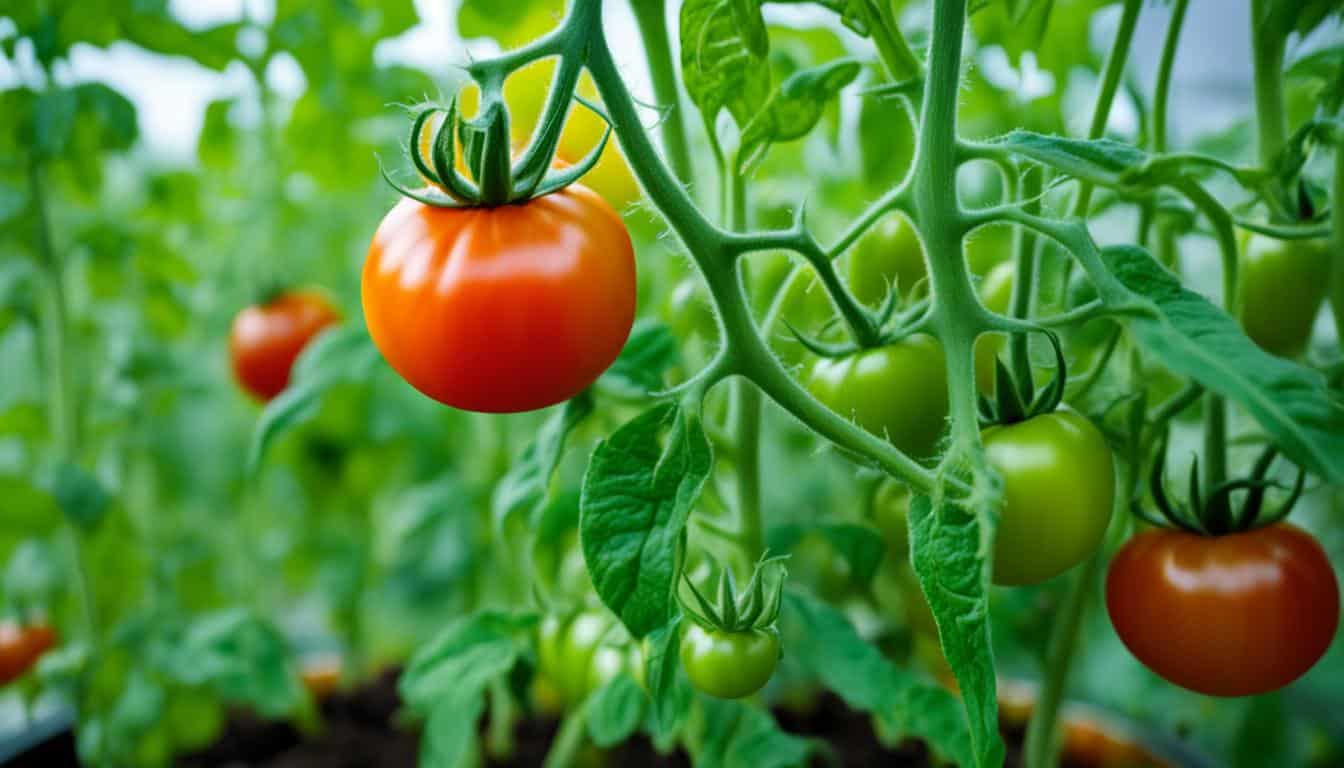
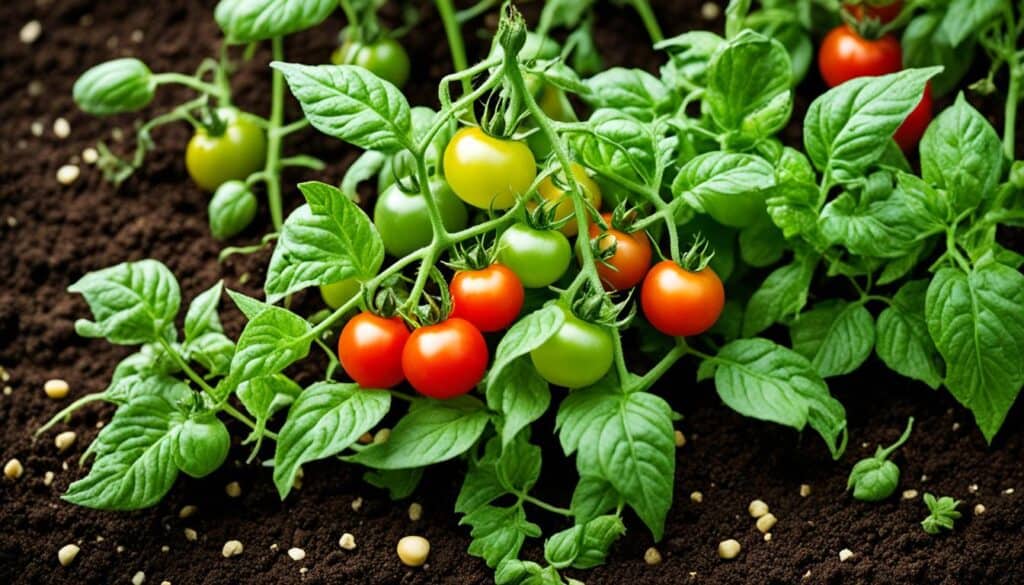
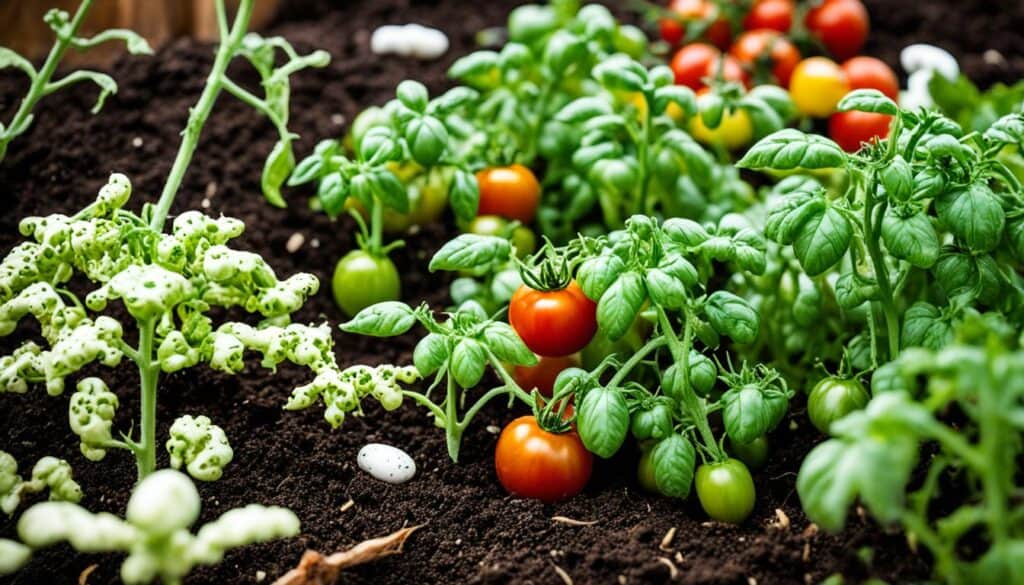
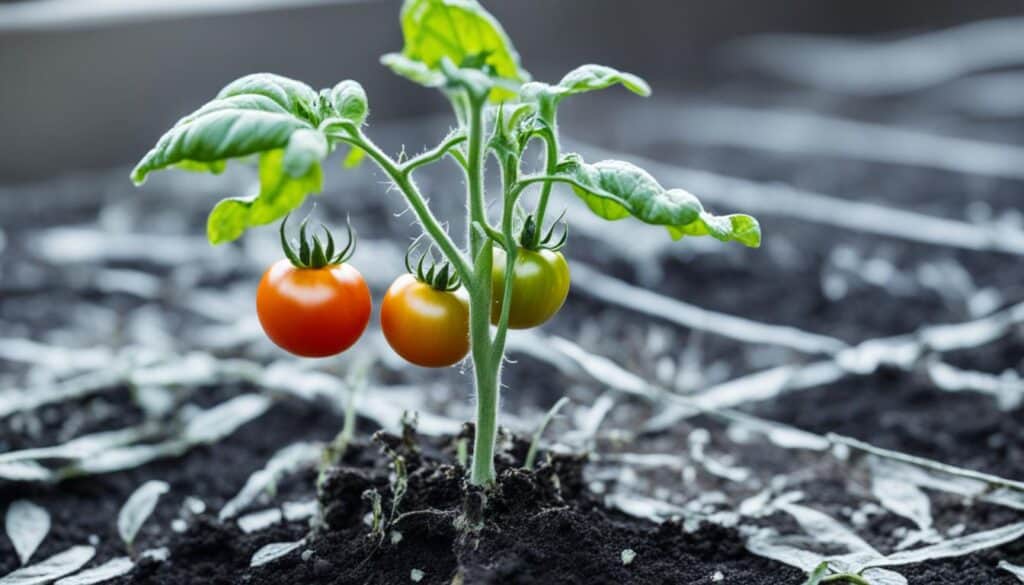
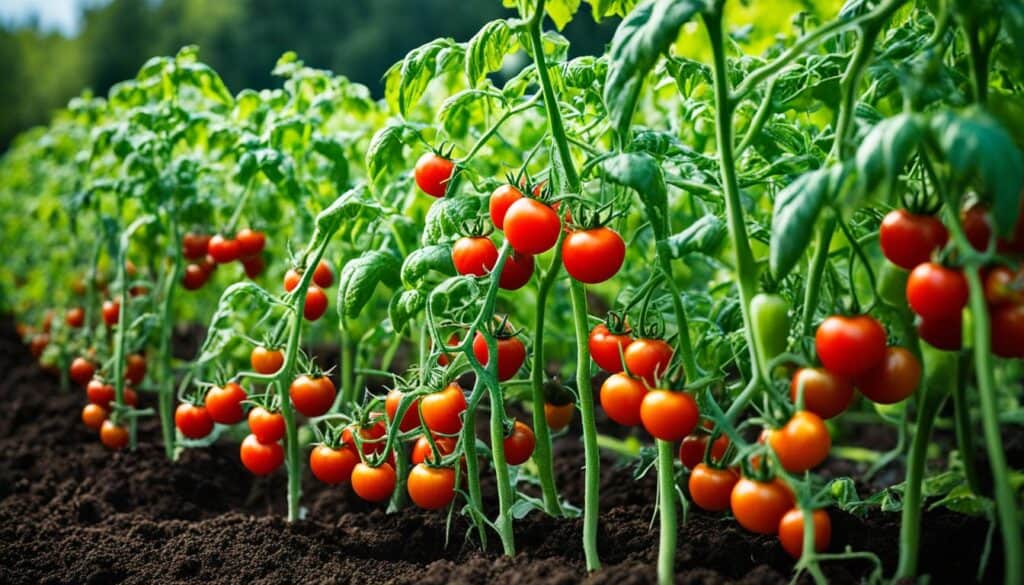
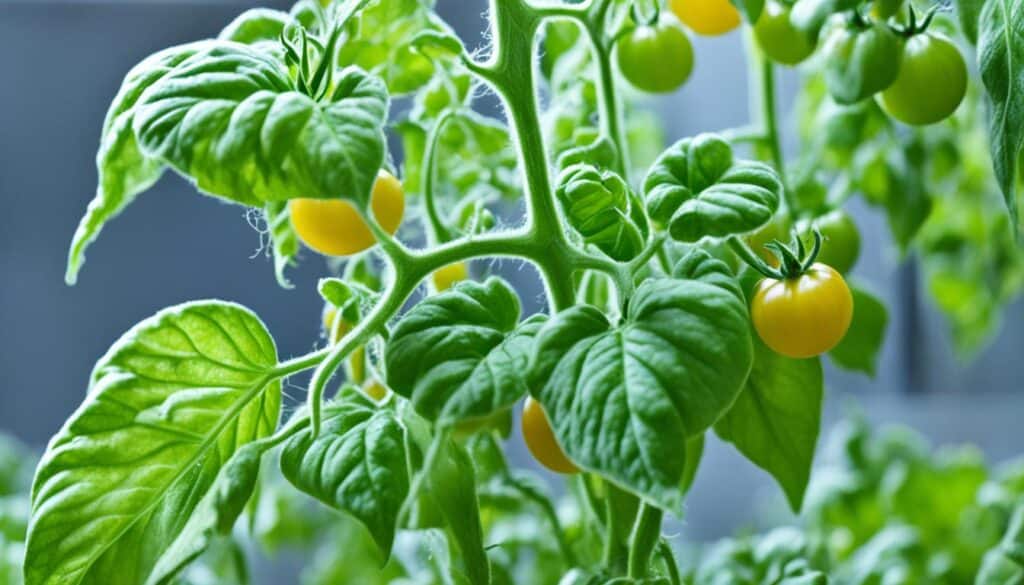



Leave a Reply